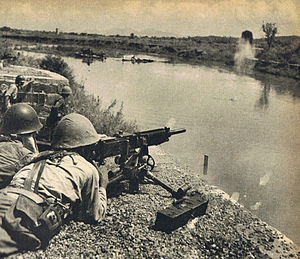Battle for Changsha (1941)
| date | September 6 - October 8, 1941 |
|---|---|
| place | Changsha in the southern Chinese province of Hunan |
| output | Chinese victory |
| Parties to the conflict | |
|---|---|
| Commander | |
| Troop strength | |
| 120,000+ infantry, air force, navy |
|
| losses | |
|
10,000 dead, several thousand wounded |
|
1937–1939
Marco Polo Bridge - Beijing-Tianjin - Chahar - Shanghai ( Sihang warehouse ) - Beijing-Hankou Railway - Tianjin-Pukou Railway - Taiyuan ( Pingxingguan , Xinkou ) - Nanjing - Xuzhou ( Tai'erzhuang ) - Henan - Lanfeng - Amoy - Wuhan ( Wanjialing ) - Canton - Hainan - Nanchang - ( Xiushui ) - Chongqing - Suixian-Zaoyang - ( Shantou ) - Changsha (1939) - South Guangxi - ( Kunlun Pass ) - Winter Offensive - ( Wuyuan )
1940–1942
Zaoyang-Yichang - Hundred Regiments - Central Hubei - South Henan - West Hebei - Shanggao - Shanxi - Changsha (1941) - Changsha (1942) - Yunnan-Burma Road - Zhejiang-Jiangxi - Sichuan
1943–1945
West Hubei - North Burma and West Yunnan - Changde - Ichi-gō - Henan - Changsha (1944) - Guilin – Liuzhou - West Henan and North Hubei - West Hunan - Guangxi (1945) - Manchukuo (1945)
The Battle of Changsha , which lasted from September 6 to October 8, 1941, was the second Japanese attempt to take the city of Changsha in the central southern Chinese province of Hunan during the Second Sino-Japanese War .
overview
The offensive was carried out by around 120,000 Japanese soldiers including the naval and air forces. Under the command of General Xue Yue , the 9th Chinese Army Group defended the city in street fighting. Ten Chinese armies reached the city to completely recapture it. The Japanese mourned more than 10,000 deaths and withdrew.
Course of the battle
The battle began with a clash between a small Chinese guerrilla unit and the Japanese 6th Division in the mountains southeast of Yueyang on September 6th. On the 17th, the Japanese crossed the Xinqiang River in four places and advanced rapidly. The Miluo River could only be crossed two days later. The main Chinese units could not bring the Japanese to battle, but marched parallel to them and followed south. The Japanese also tried to encircle the Chinese on their flank. This inevitably led to a clash of armies on the Laodao River .
On September 27th, several hundred Japanese in civilian clothes reached the north gate of Changsha, but were unable to sabotage the city's defenses, which led to heavy fighting the following day. Since the defenders could not be overcome, the Japanese army began a complete retreat to Yueyang on September 30th.
